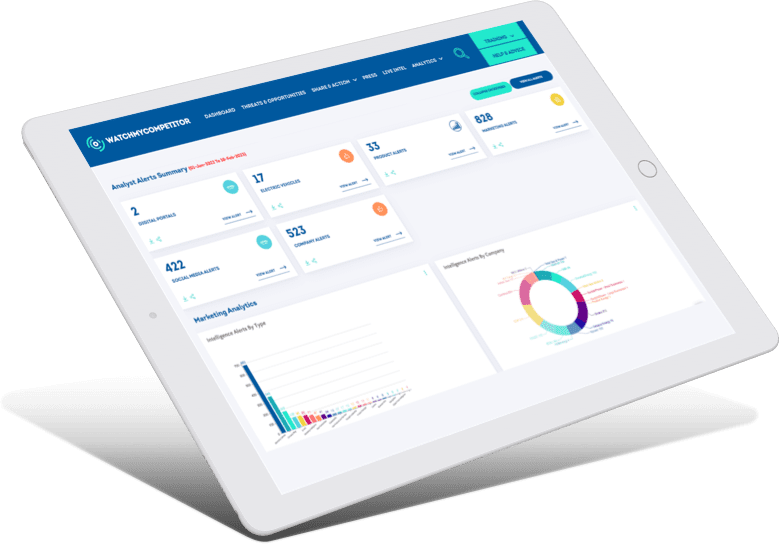Pricing is one of the most powerful and strategic tools you have at your disposal to preserve and expand your revenue. It is one of the key drivers for your profitability, market positioning, customer perception and growth.
Your pricing is also the most visible and flexible element of your marketing mix, as it allows you to respond quickly and effectively to changing market conditions and customer expectations. In today’s competitive market environment where customers have access to a plethora of options — you need to adopt a competitive pricing strategy that aligns with your value proposition, market positioning, and business goals.
In this article you will learn about the benefits, challenges and best practices of competitive pricing, as well as the tools and technologies that can help you achieve pricing excellence.
We will also provide you with a practical guide on how to formulate, implement, and optimise a successful competitive pricing strategy for your business.

What Is A Competitive Pricing Strategy?
A competitive pricing strategy is a method of setting and adjusting the price of your products or services, based on the prices set by your competitors. It’s a pivotal component of revenue management because it directly impacts your profitability.
Competitive pricing requires a data-driven approach that involves staying up-to-date with current market dynamics and customers’ expectations, then adjusting your prices accordingly.
By aligning your pricing strategy with market dynamics, you ensure that your prices reflect the current state of the market — making your offering more attractive to customers.
When your pricing matches customers’ expectations you have the ability to increase customer acquisition, improve customer satisfaction, boost retention rates, and enhance your brand’s reputation.
The Benefits Of A Strategic Pricing Approach
Adopting a strategic approach to pricing offers several short-term and long-term advantages that can significantly impact your revenue growth. The main benefits of implementing a competitive pricing strategy include:
1) Enhanced customer value perception
A competitive pricing strategy can help enhance the perceived value of your products or services. When your prices align with the market and customer expectations, customers are more likely to see your offering as valuable and worth their cost.
2) Increased customer loyalty
Strategic pricing can help promote and foster customer loyalty. By offering prices that customers perceive as fair and competitive, you’re more likely to retain existing customers and turn them into repeat buyers.
3) Sustained revenue growth
A well-implemented competitive pricing strategy contributes to sustainable revenue growth. By strategically setting prices that are both competitive and profitable, you can drive higher sales volumes, which in turn leads to an increase in overall revenue.
Analysing Competitor Pricing
To develop a competitive pricing strategy, you need to have a clear and accurate picture of your competitor’s prices — as well as a comprehensive understanding of their pricing strategies, tactics, and objectives.
This process involves utilising tools and methodologies that enable you to monitor, collect, process, and interpret relevant competitor pricing data. By leveraging the right mix of tools and methodologies, you can derive data-backed insights on competitor pricing strategies to inform your own pricing decisions.
Some of the most effective tools and methodologies for analysing competitor pricing include:
A) Price comparison websites
These are websites that allow you to compare prices of products or services from different sellers and providers.
B) Pricing surveys
This method allows you to gather insights on customer perceptions of competitor prices and strategies through interviews and focus groups.
C) Competitive intelligence tools
These specialised software solutions utilise advanced algorithms to gather and analyse competitor pricing data in real-time from various sources.

Setting & Adjusting Prices
Setting and adjusting prices based on a competitive pricing strategy is a dynamic process. It requires a careful analysis of various factors that influence the optimal price points for your products or services.
Some of the key factors to consider are:
Cost considerations
The first step in setting prices is understanding your costs. This includes both fixed costs (like rent or salaries) and variable costs (like materials or shipping). Your price should cover these costs and also provide a reasonable profit margin.
Market positioning
Your price also reflects your brand’s position in the market. If you position your brand as a premium offering, your prices should reflect that. Conversely, if you’re positioning your brand as a cost-effective option, your prices should be more competitive.
Customer sensitivity
Understanding how price-sensitive your customers are is crucial. If your customers are highly sensitive to price changes, even a small increase could lead to a significant drop in sales.
On the other hand, if your customers value your product highly and are not very price-sensitive, you might have room to increase your prices without negatively impacting sales.
Navigating Competitive Pressures
A competitive pricing environment often poses numerous challenges and pressures that you need to be aware of, such as the following:
1) Avoiding price wars
One of the most common challenges with competitive pricing is the pressure to engage in price wars. This occurs when competitors engage in a series of aggressive price cuts to attract customers and gain market share.
Engaging in a price war can have severe consequences for your business, such as eroding your profit margins and devaluing your product in the eyes of consumers.
To avoid or exit a price war, you should focus on creating and communicating a value proposition that differentiates your products or services from your competitors’ — and set your prices to reflect the perceived value of your unique offering.
2) Managing profit margins
Another common challenge in a competitive pricing environment is managing margins for sustained growth and profitability. This entails striking a balance between maintaining a competitive price in the market and ensuring you remain profitable.
Managing your margins effectively involves closely monitoring your costs, improving operational efficiency, and strategically adjusting your prices based on changing market trends and conditions.
3) Staying resilient in fluctuating markets
To succeed in a competitive pricing environment, you must have the ability to remain resilient amid market fluctuations that can affect your pricing strategy and performance. Market fluctuations encompass any shifts in supply and demand, customer preferences, or competitor actions that impact market conditions.
Staying resilient in a fluctuating market requires a comprehensive understanding of the competitive landscape, an agile approach to your pricing strategy, and the ability to make quick, data-driven decisions.
Leveraging Technology For Pricing Excellence
Technology plays a vital role in helping you achieve pricing excellence as it enables you to automate, streamline, and optimise your competitive pricing process. The core benefits of leveraging technology to guide your competitive pricing decisions include:
A) Efficiency
Save time and resources by automating and simplifying your pricing tasks, such as data collection, analysis, monitoring and reporting. Technology can also help reduce errors and inconsistencies by standardising and validating your pricing data and calculations.
B) Accuracy
Improve the quality and reliability of your pricing data and analysis by utilising advanced algorithms and artificial intelligence. Technology can also help you update and refine your pricing strategies by using feedback and machine learning mechanisms.
C) Agility
Respond faster and more effectively to changes in the market, such as demand fluctuations, cost variations, or competitor actions. Technology can also help you test and experiment with different pricing scenarios or options, and measure their impact.
C) Visibility
Gain more visibility and transparency into your pricing performance and activities by using dashboards, reports, and alert systems. Technology can also help streamline the sharing of pricing information and insights with relevant stakeholders like sales teams and management.
The Power of Competitive Intelligence Platforms
One of the most effective ways to achieve pricing excellence is to utilise a competitive intelligence platform to make data-driven decisions.
This specialised technology enables you to gather, monitor, track and analyse competitor prices in real-time — providing you with a comprehensive overview of the competitive landscape and current market dynamics.
Competitive intelligence platforms also allow you to analyse historical trends, make side-by-side comparisons, set price alerts, and monitor specific competitors in the market.
Implementing A Competitive Pricing Strategy
Implementing a competitive pricing strategy involves a systematic approach. Below is a step-by-step guide on how to implement a successful competitive pricing strategy for your business.
1) Understand your costs
Make sure you start with a clear understanding of your costs. This includes both fixed and variable costs associated with your product or service.
2) Analyse the competition
Next, conduct a thorough analysis of your competitors’ pricing strategies. This will give you a benchmark for setting your own prices.
3) Understand your customers
Gain insights into your customers’ price sensitivity and their perceived value of your product or service. This will help you set a price that your customers are willing to pay.
4) Set your prices
Based on your cost, competition, and customer analysis, set your initial prices. Make sure your prices are competitive, align with your customers’ perceived value, and maintain a healthy profit margin.
4) Monitor & adjust
Once your prices are set, it’s important to continuously monitor market and customer responses. Be prepared to adjust your prices as needed to stay competitive and meet your business objectives.
Measuring Success & Optimisation
Measuring the success of a competitive pricing strategy involves defining and measuring key performance indicators (KPIs). Some of the most important KPIs for competitive pricing are:
A) Revenue growth rate
This measures the percentage change in your revenue over time. It indicates how well your pricing strategy is driving sales volume and customer retention. You want to see a positive and consistent revenue growth rate that reflects your market potential and customer demand.
B) Profit margin
This measures the ratio of your profit to your revenue. It indicates how well your pricing strategy is generating profit while covering your costs. You want to see a high and stable profit margin that reflects your value proposition and competitive advantage.
C) Price elasticity of demand
This measures the responsiveness of your customers to changes in your prices. It indicates how sensitive your customers are to price fluctuations and how much they are willing to pay for your products or services. You want to find the optimal price point that maximises your revenue and profit, without losing customers or market share.
D) Market share
This measures the percentage of the total market that you capture with your products or services. It indicates how well your pricing strategy is positioning you against your competitors and how loyal your customers are to your brand. You want to see a high and growing market share that reflects your customer satisfaction and differentiation.
Strategies For Ongoing Optimisation
To ensure the effectiveness and sustainability of your competitive pricing strategy, you need to implement ongoing optimisation strategies that allow you to adapt and improve your pricing decisions. Strategies for ongoing optimisation of your competitive pricing strategy can include:
A) Market research
Conduct regular market research to understand your customers’ needs, preferences, and willingness to pay. This will help you identify opportunities and threats in the market so you can adjust your prices accordingly.
B) Customer segmentation
Segment your customers based on their characteristics, behaviour and value. This will help you tailor your prices to different customer groups and offer them the best value for their money. You can use various criteria to segment your customers, such as demographics, psychographics, purchase history and loyalty.
C) Feedback loops
Collect and analyse feedback from your customers, competitors, and stakeholders to evaluate the effectiveness of your pricing strategy and tactics. You can use various methods to gather feedback, such as surveys, reviews, ratings, and testimonials. Feedback loops will help you identify the strengths and weaknesses of your pricing strategy and make data-driven adjustments.
D) Data-driven adjustments
Use data to inform your pricing decisions. This could involve leveraging technology such as competitive intelligence tools to stay updated on the latest market trends, competitor prices, and customer expectations. Based on this data, you can make informed decisions about whether to adjust your prices and by how much.
Concluding Thoughts
In today’s hyper-competitive market, safeguarding and growing revenue is a top priority. A well-crafted competitive pricing strategy plays an essential role in helping you achieve this goal because it allows you to set optimal prices for your products or services.
You have to be aware that the prices you set for your products or services are more than just numbers. It’s a powerful signal that communicates how much value you offer compared to your competitors.
To set the right signal, you need a competitive pricing strategy that aligns your prices with current market conditions and customer expectations. This will ensure customer satisfaction and sustainable growth for your business.


